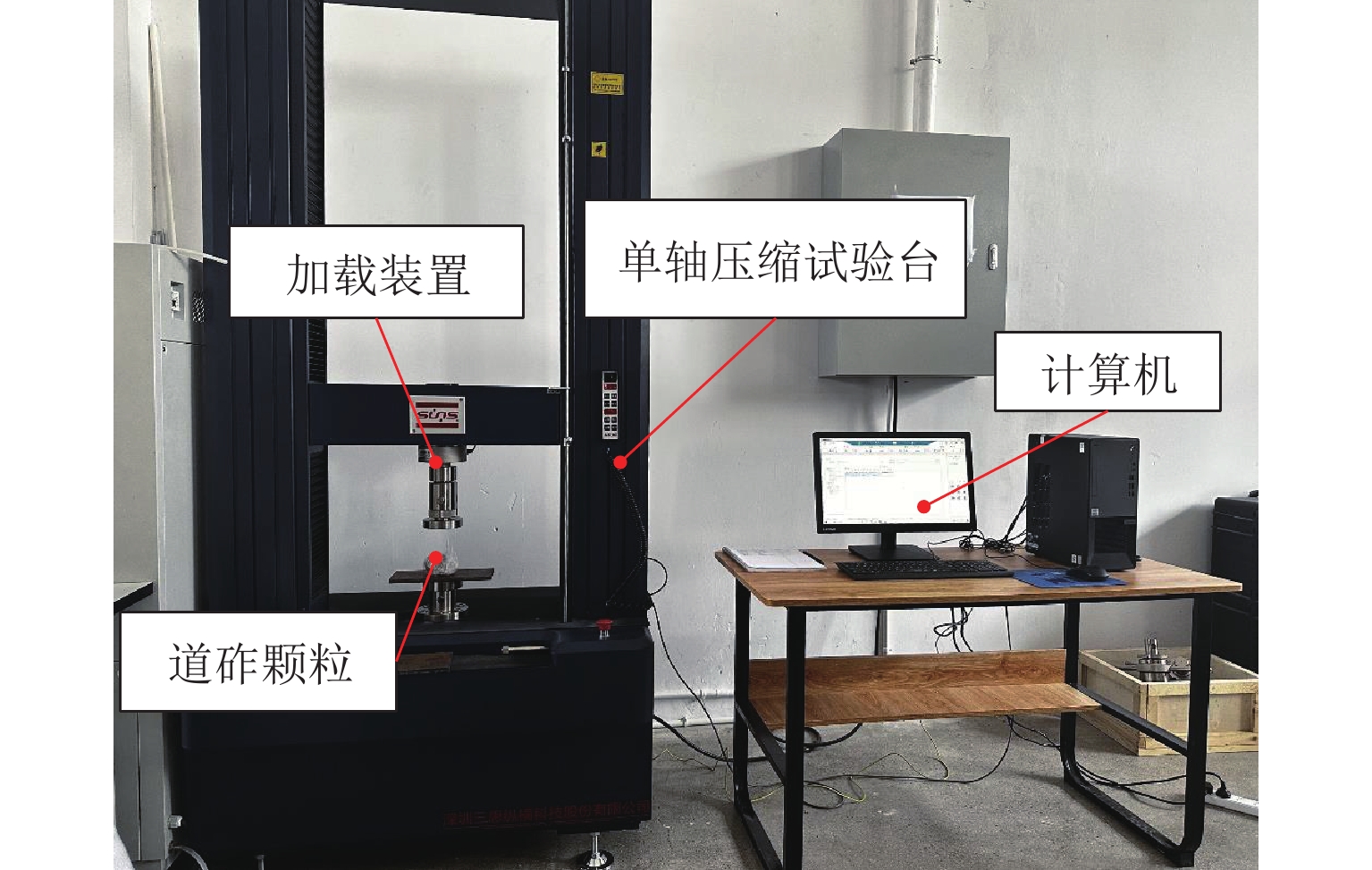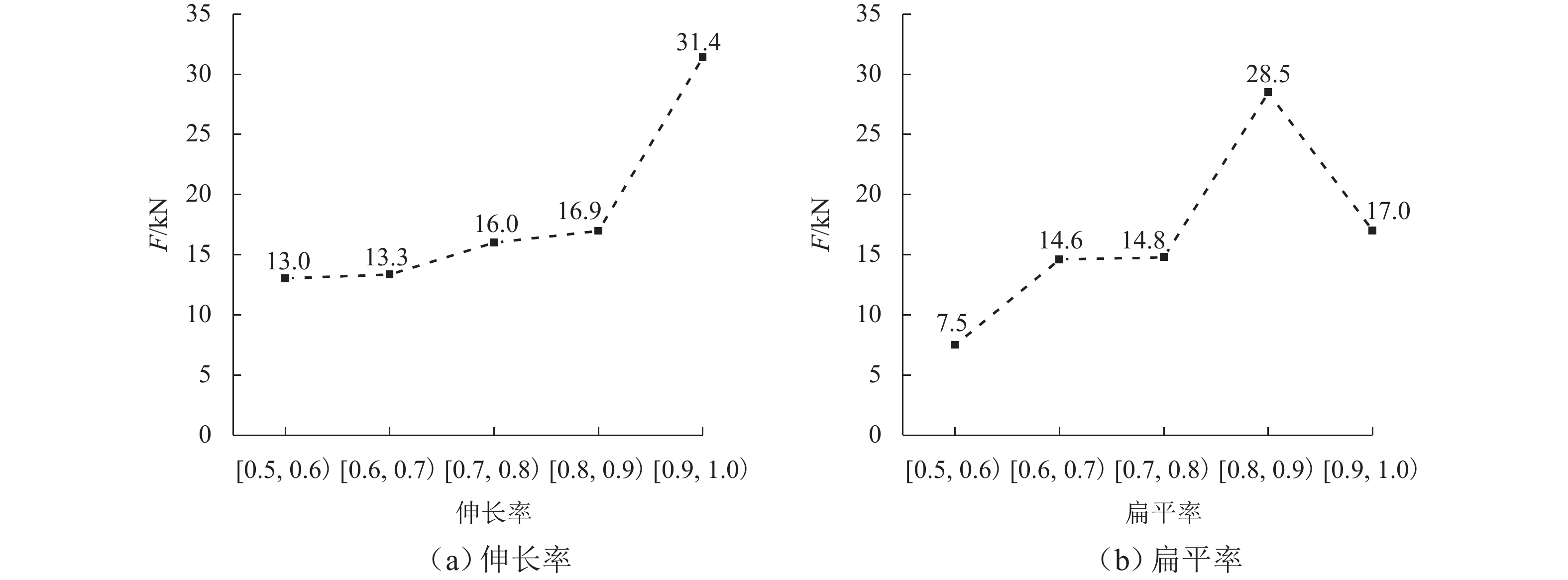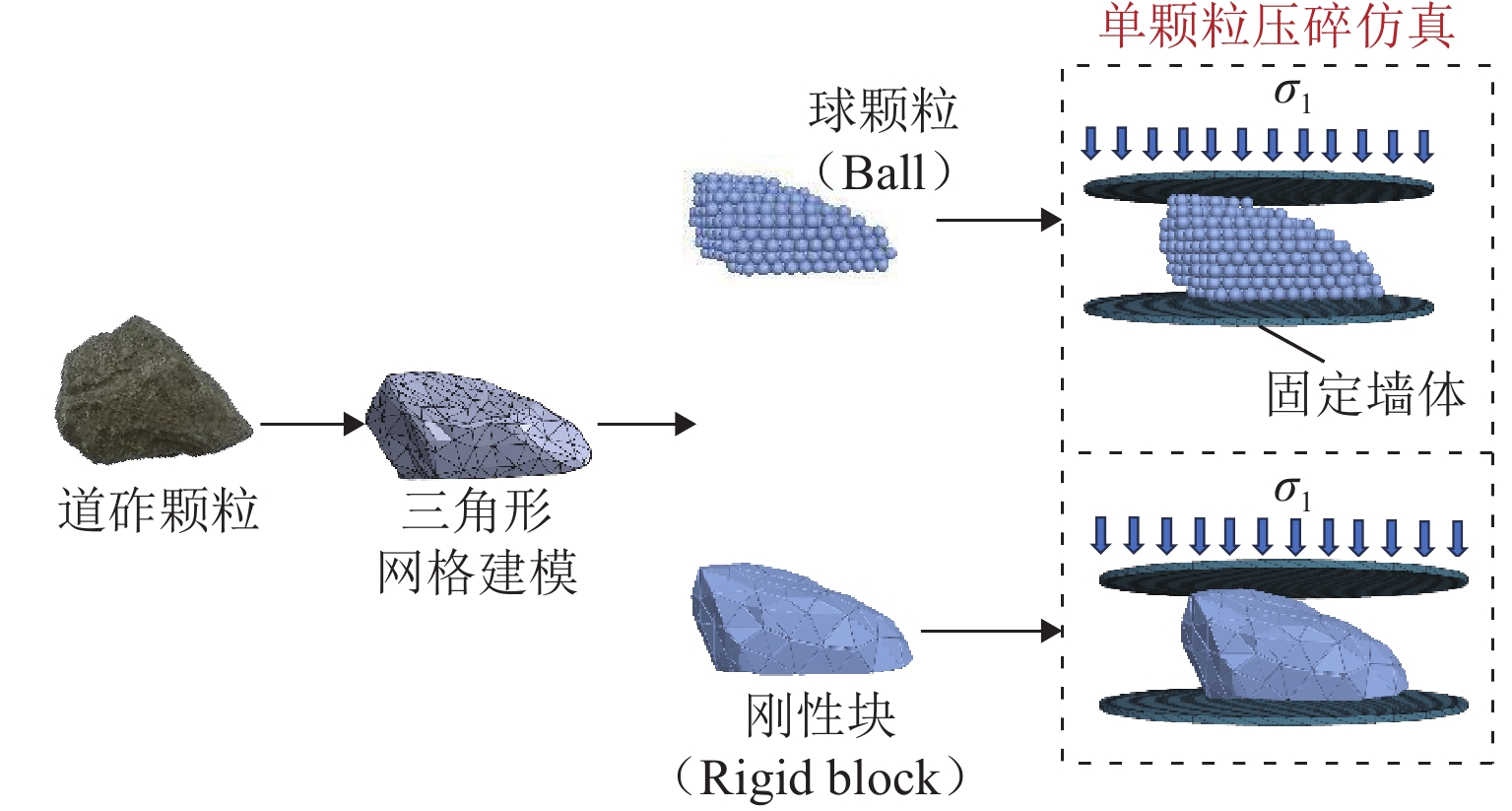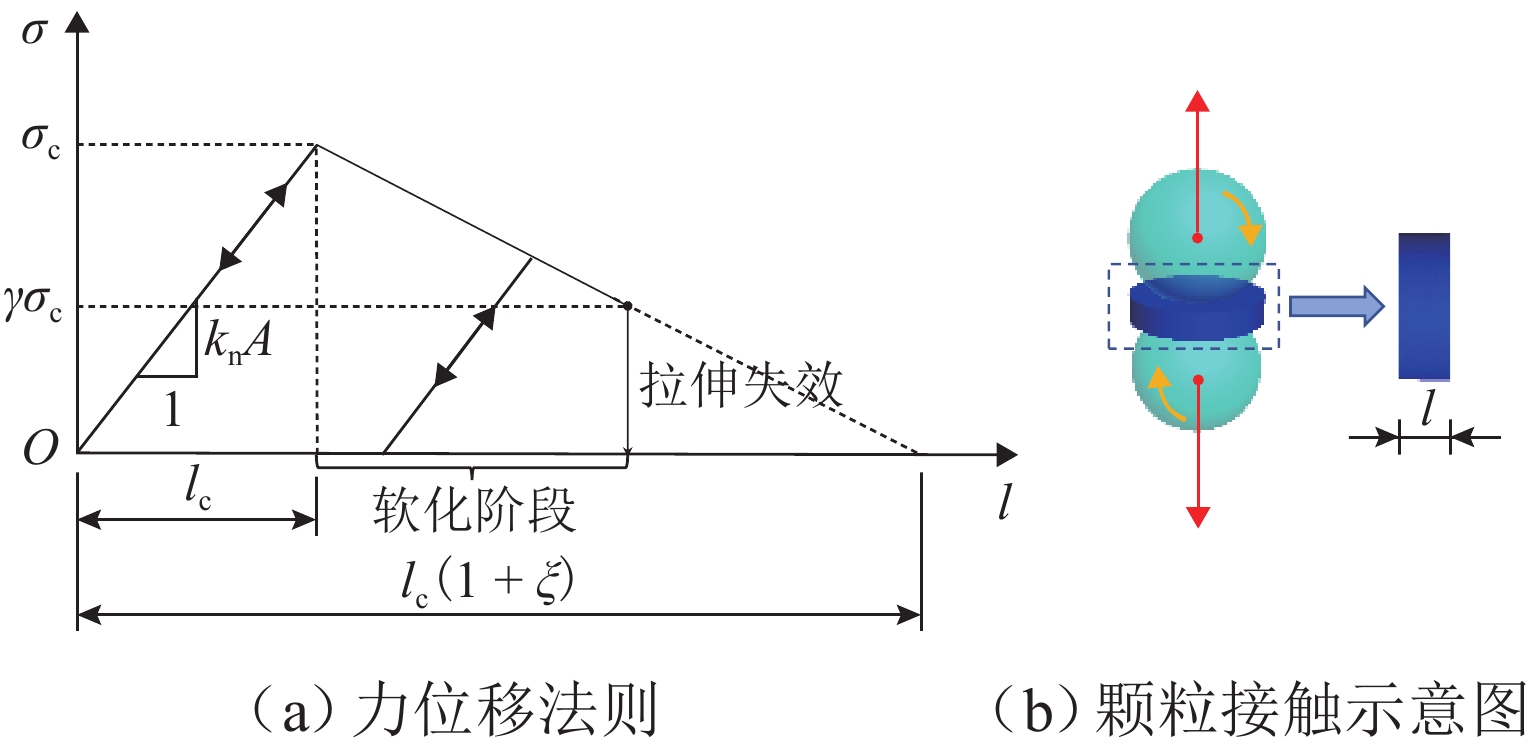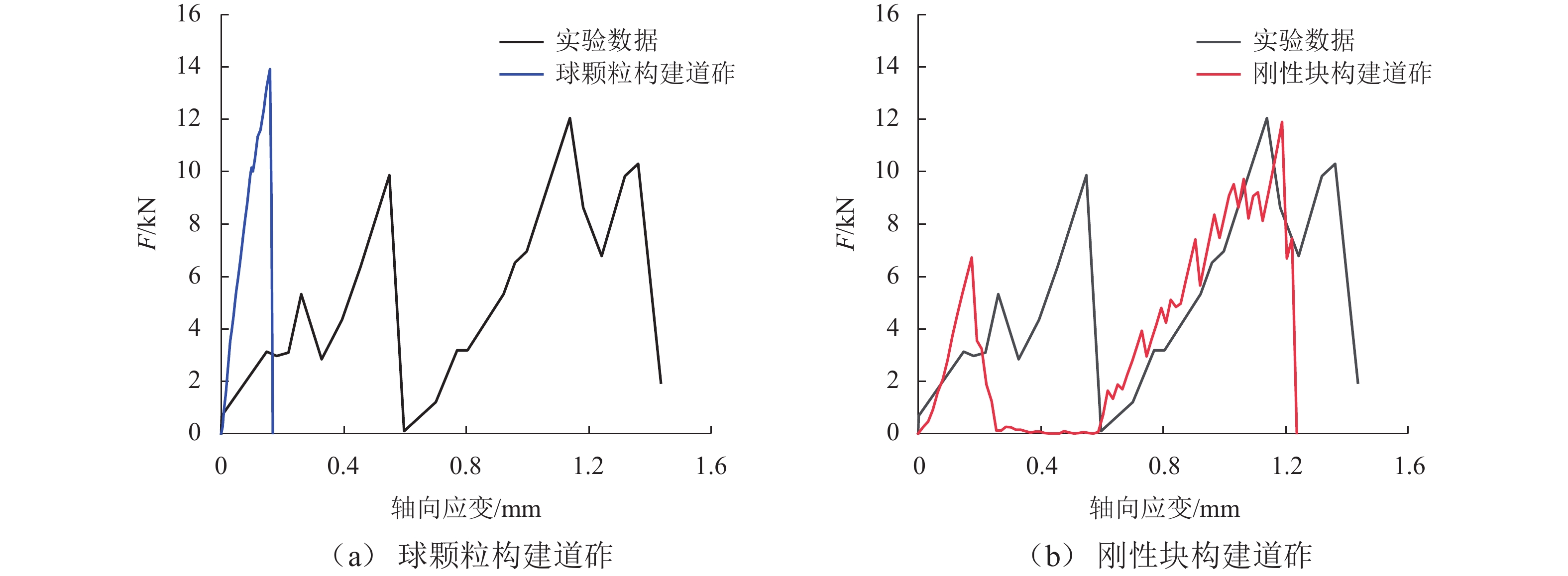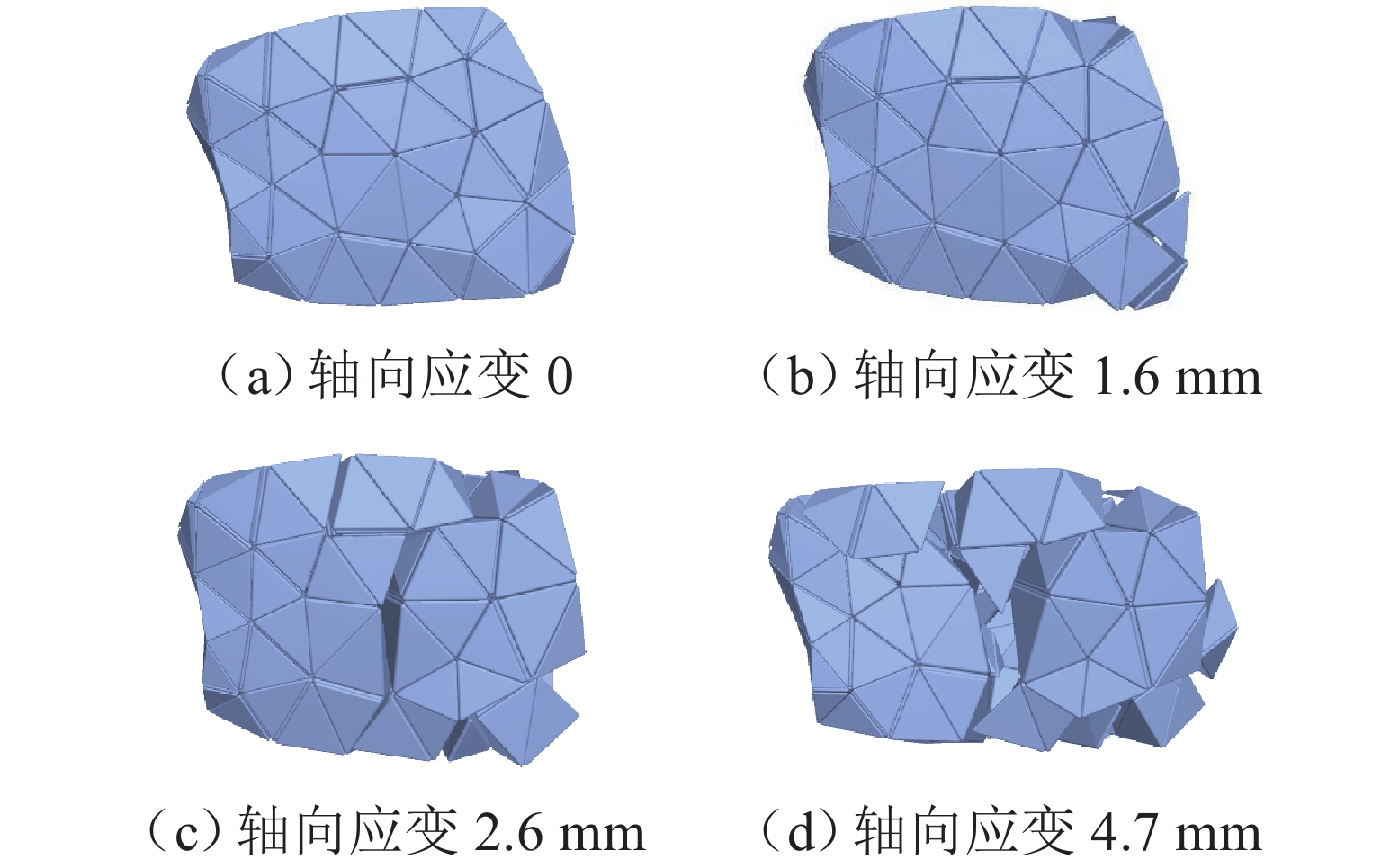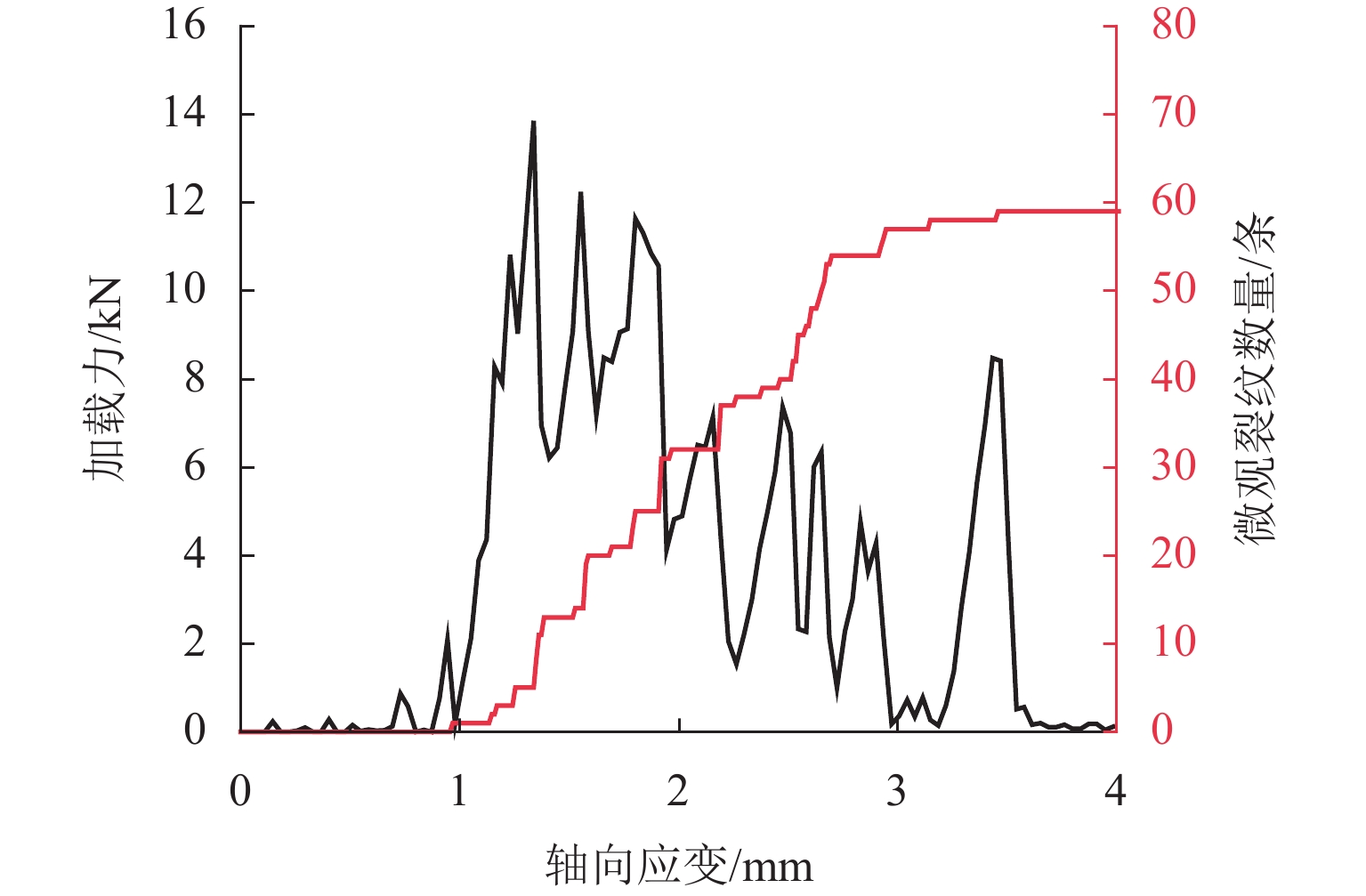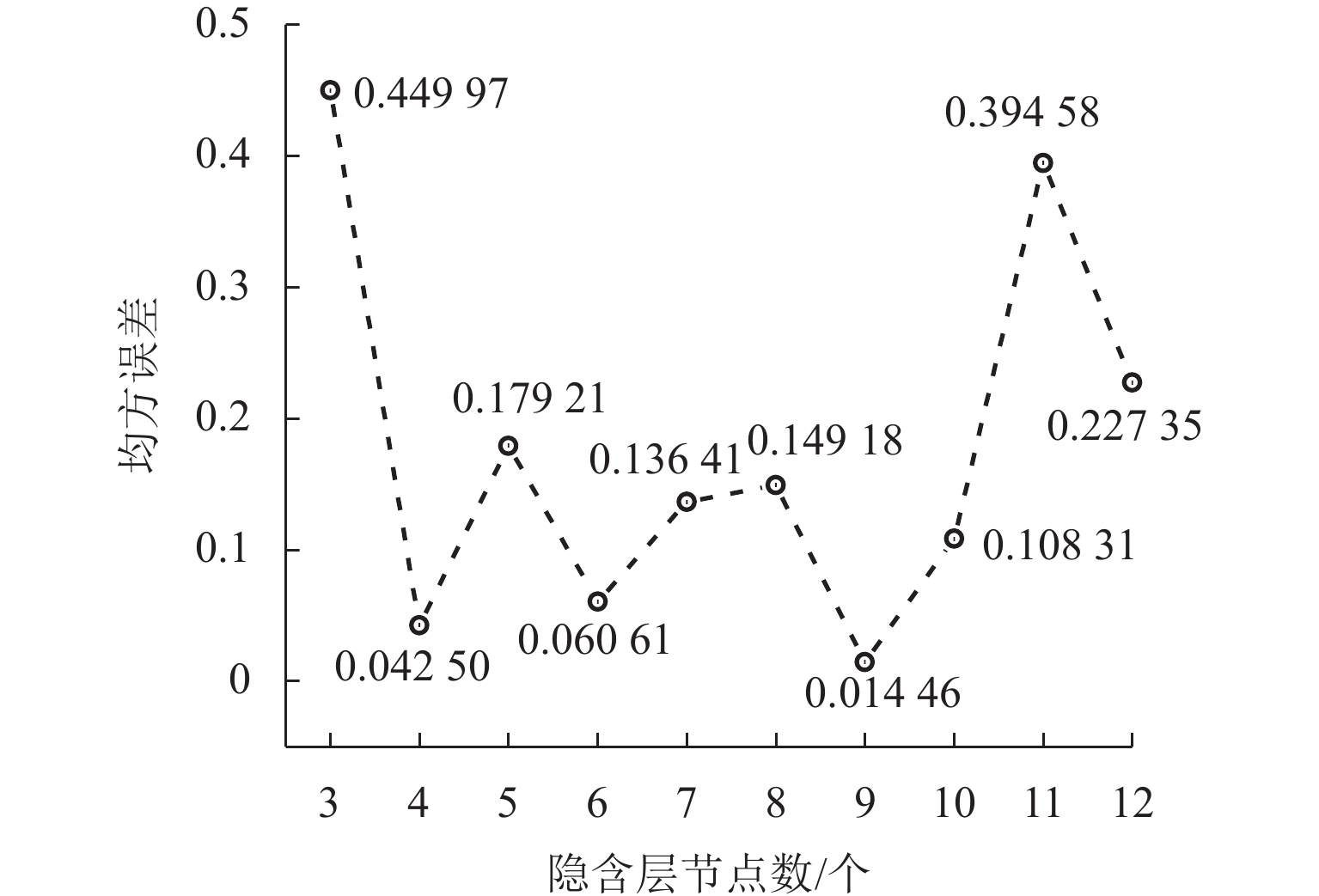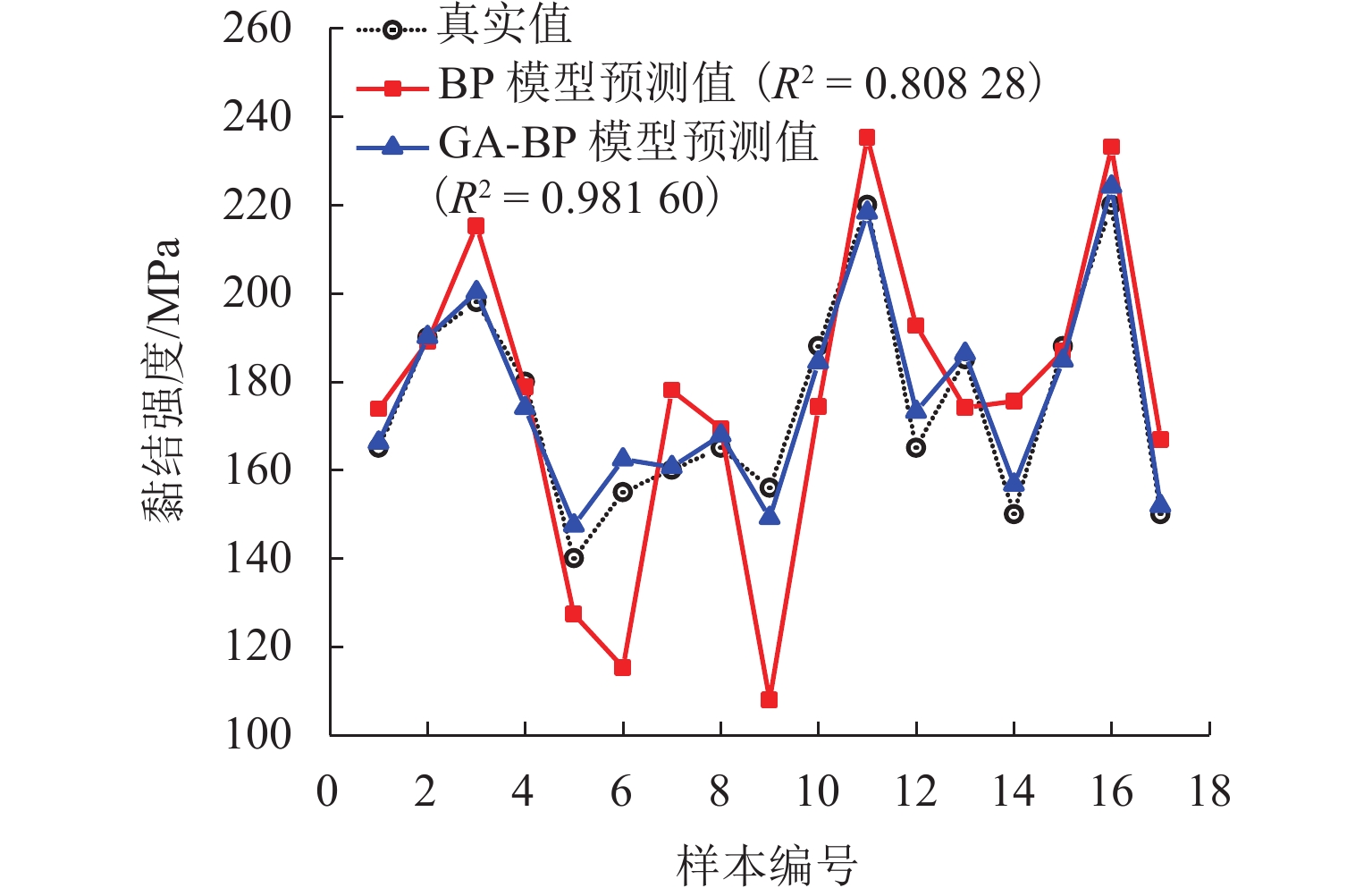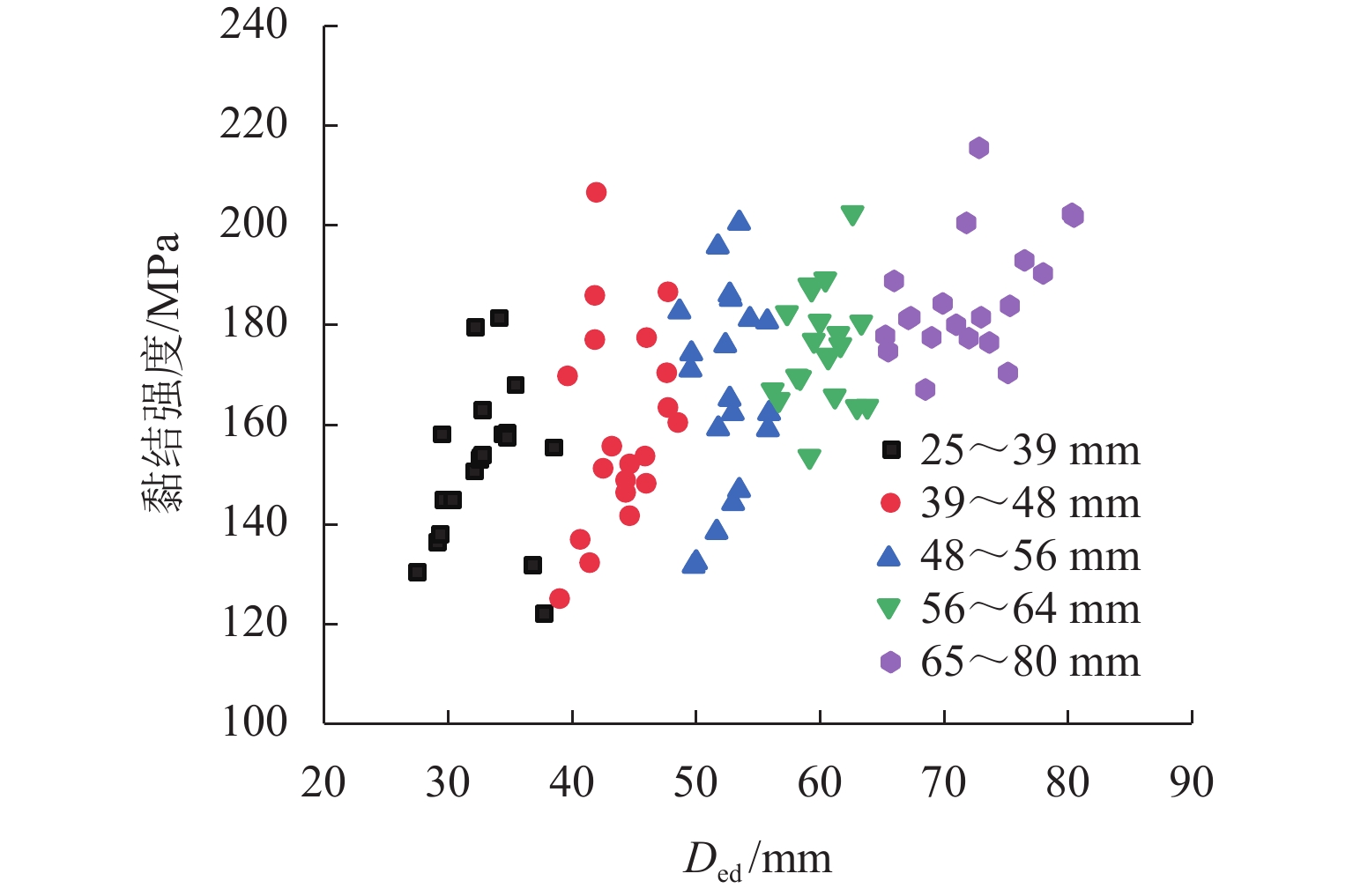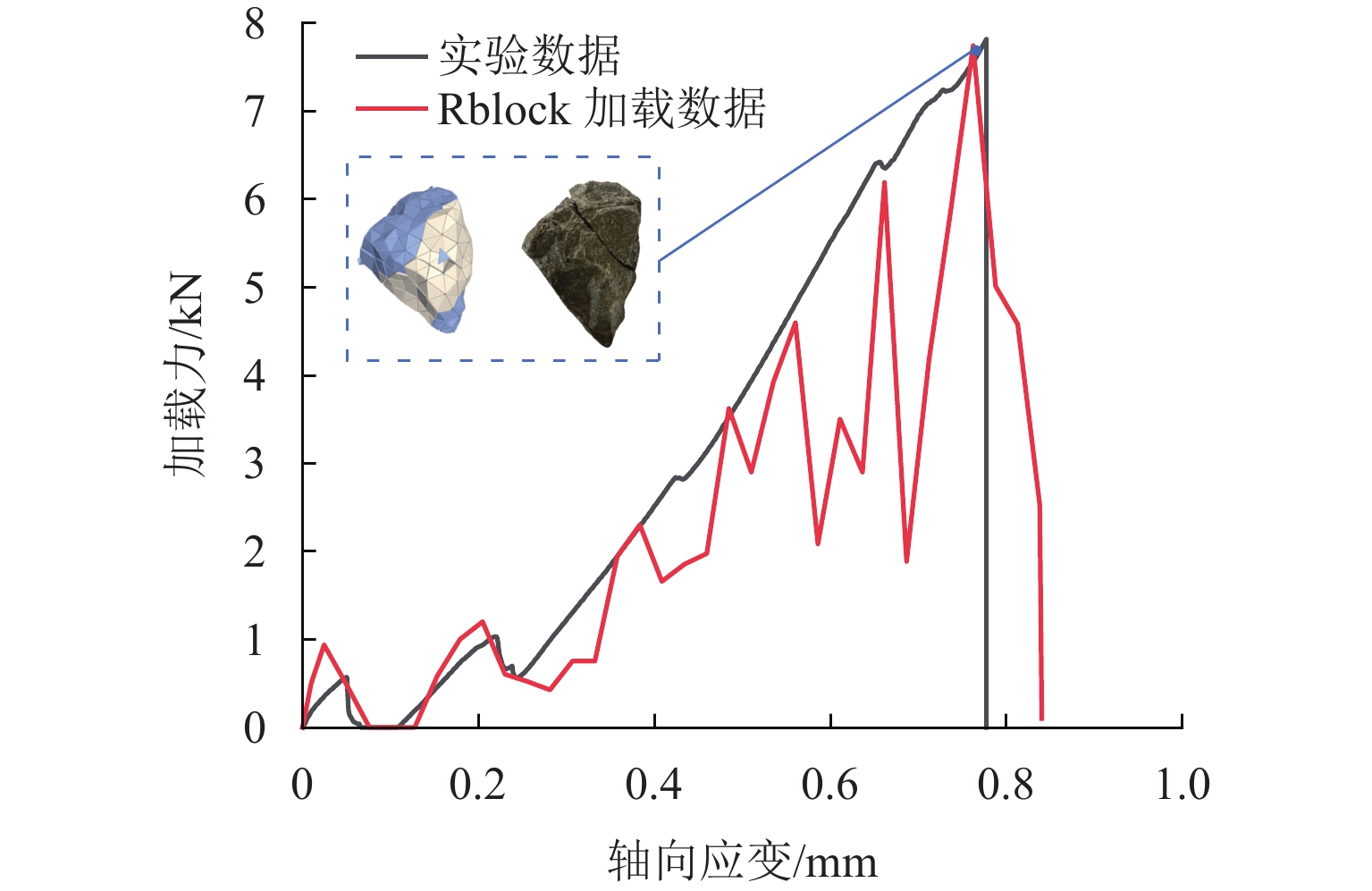Prediction of Discrete Element Breakage Parameter for Ballast Particles Based on Genetic Algorithm–Back Propagation Neural Network Model
-
摘要:
为优化有砟道床的劣化评估与养护维修,针对道砟颗粒破碎过程及破碎机理的研究具有重要价值. 通过对单个道砟颗粒进行单轴压碎实验,确定破坏所需的等效应力,依据道砟颗粒的破碎过程和加载力对其受载变形行为进行分析;通过激光光栅扫描道砟颗粒的几何外形,使用最小外接矩形法对其进行规定,同时,采用刚性块进行道砟颗粒填充,并与传统球颗粒填充方式作对比,分析了使用刚性块所构造道砟颗粒的破碎过程以及道砟颗粒内部微裂纹萌生情况;此外,研究不同几何外形道砟颗粒的离散元接触参数,采用遗传算法优化的神经网络模型(GA-BP)预测不同等效粒径道砟颗粒对应的黏结强度. 研究结果表明:在离散元中,道砟颗粒的黏结强度随着等效粒径的增加而增加, 当等效粒径为[25,39)、[39,48)、 [48,56)、[56,64)、[64,80) mm时,对应的平均黏结强度分别为151.85、159.45、166.71、175.29、185.29 MPa.
Abstract:To optimize the deterioration assessment and maintenance of ballasted tracks, it is of great value to study the breakage process and mechanism of ballast particles. Through a uniaxial breakage test on the single ballast particle, the equivalent stress required for its failure was determined. The deformation behavior under load was analyzed based on the ballast particle breakage process and loading force. Laser grating scanning of the ballast particle geometry was performed, and a minimum bounding rectangle method was used for specification. Rigid blocks were used for ballast particle packing, and a comparison was made with the traditional spherical particle packing method. The breakage process of ballast particles constructed with rigid blocks and the initiation of microcracks within the ballast particles were analyzed. In addition, the discrete element contact parameters for ballast particles with different geometries were studied, and a neural network model optimized by a genetic algorithm, namely GA-BP was used to predict the bond strength for ballast particles with different equivalent particle sizes. The results show that in the discrete element model, the bond strength of the ballast particles increases with the increase in its equivalent particle sizes. Specifically, for equivalent particle sizes in the ranges of [25, 39), [39, 48), [48, 56), [56, 64), and [64, 80) mm, the corresponding average bond strengths are 151.85, 159.45, 166.71, 175.29, and 185.29 MPa, respectively.
-
Key words:
- discrete element method /
- rigid block /
- neural network /
- bond strength /
- ballast particle breakage
-
有砟道床由大量散体道砟颗粒组成,可保持列车稳定行驶、扩散列车作用在铁轨上的载荷、减小振动吸收轮轨冲击等功能[1]. 但由于道砟颗粒的尺寸形状具有很强的随机性,并且大多数道砟颗粒存在一定棱角,当其在道床中受到载荷时会产生局部破碎甚至整体破坏,会影响道床整体稳定性使得铁轨发生变形和破损,还会使得道床整体发生不同程度的沉降[2]. 因此,深入探讨道砟颗粒破碎过程以及破碎机理对有砟道床的劣化评估与养护维修具有重要研究价值.
由于道砟颗粒的几何外形随机性高,导致其破碎机理较为复杂,但仍可以将道砟颗粒破碎分为棱角破碎和整体破坏. 据研究表明,道砟颗粒的破碎与其拉伸强度相关:Mcdowell等[3]通过对道砟颗粒压碎实验数据的分析发现,其拉伸强度服从威布尔分布. 自离散单元法(DEM)提出以后,针对道砟颗粒破碎的数值模拟逐渐增多:Indraratna等[4]在二维尺度使用球型颗粒构造几何外形不规则颗粒并进行三轴压缩实验,探讨其在循环载荷下的破碎机理;Lim[5]在三维尺度使用8个球颗粒构建了形状规则的道砟颗粒并进行道砟箱实验,此方法可以更好地模拟道砟颗粒的几何特征但仍存在很大区别;严颖等[6]使用离散元软件对道砟颗粒的压破实验进行数值模拟得到了道砟颗粒的尺寸越大其破碎率越大,并对道砟颗粒的离散元接触模型粘结参数进行了标定. 由于缺乏对道砟颗粒几何形态特征的统计分析,在DEM中对刚度、摩擦、阻尼以及颗粒间黏结强度等细观力学参数的标定可能存在偏差[7]. 为了更准确地研究道砟颗粒的受载破碎行为,改进道砟颗粒形状以及道砟颗粒内部的性能参数成为当前的趋势[8].
同时,在离散元软件中为了准确地分析道砟颗粒破碎情况以及其内部微裂纹萌生情况,需要选用更为精细的接触模型以及设置与真实道砟颗粒破碎情况相对应的黏结强度. 目前,国内外学者对道砟颗粒离散元接触参数的研究主要基于单个几何外形评价参数,在接触模型选用上多使用Potyondy等[9]提出的平行粘结模型. 但由于道砟颗粒的几何外形具有随机性以及复杂性,使用单一参数无法准确地描述道砟颗粒的几何外形,所以需要设置多个参数对道砟颗粒的破碎进行定义以此确定其黏结强度.
反向传播(BP)神经网络通过对数据集内部包含的关系进行预测并按照误差反向传播训练,通过不断迭代训练出最优模型,其拥有很强非线性映射能力,很适合求解多元非线性问题[11]. Ren等[12]在离散元软件Particle Flow Code(PFC)中使用BP 神经网络对平行粘结模型进行了细观黏结键参数标定,验证了 BP 神经网络在离散元方法中应用的有效性;Wang等[13]采用神经网络对参数标定以及校核了标定结果流程进行了研究. 但由于 BP 神经网络在训练过程中的拟合程度取决于样本的规律性和数量,规律性不强时预测结果不准确. 通过将遗传算法(GA)与BP神经网络结合,使用GA的迭代搜索寻优功能选取最优BP神经网络参数,增加BP神经网络模型预测精度,可以很好地提高预测精度[14-15].
为此,本文通过激光光栅扫描的方法得到道砟颗粒的几何参数并对其进行几何外形尺寸定义. 将构造好的道砟颗粒导入离散元软件中,使用刚性块(Rigid-Block)进行填充,并与传统球颗粒(Ball)填充方法对比分析,寻找更能模拟道砟颗粒复杂几何外形以及棱角特性的建模方法,并通过Softbond模型建立黏结键. 依据道砟颗粒单轴压碎实验数据与离散元仿真加载数据对道砟颗粒黏结强度进行标定. 在此基础上,使用GA-BP神经网络模型建立起针对不同几何外形尺寸的道砟颗粒离散元接触参数预测模型,研究分析道砟颗粒几何外形尺寸与其黏结强度的关系,以此揭示道砟颗粒破碎的基本规律.
1. 道砟颗粒单轴破碎实验分析
1.1 实验设置
道砟颗粒的尺寸形状具有随机性,为了对其进行统一分析,首先对道砟颗粒的尺寸形状进行定义. 对于道砟颗粒此类不规则形状多面体,将其放置于一个长方体内,且该长方体的每一个面都与该多面体相切且得到的长方体体积最小时,此长方体可以定义为最小外接矩形.
在单颗粒压碎实验中,首先选取一定数量的不同尺寸与形状的道砟. 将道砟颗粒扫描后获取三维数据,并采用自编算法读取道砟颗粒形状参数. 基于最小包容长方体准则,得到道砟的长轴尺寸(L)、中轴尺寸(W)和短轴尺寸(T),并将长轴、中轴和短轴尺寸求和取均值,定义为等效粒径$D_{\mathrm{ed}}$,如图1.
为了进一步研究不同尺寸道砟的力学特性,选取材质为花岗岩的道砟颗粒进行研究. 在选取颗粒过程中,为了更好地研究颗粒几何外形对其破坏特性的影响,选取26组不同尺寸的扁平状、针状和类圆状道砟颗粒并对其进行单轴破碎实验.
采用的实验设备为量程为100 kN的电液伺服万能试验机,如图2所示. 将道砟颗粒的尺寸数据输入至计算机中,并将道砟放置于辅助垫块上,在实验过程中使用道砟颗粒面积最大的面作为底面放置在实验台上的. 将上加载装置下降至接近道砟的位置,此时记录道砟颗粒的摆放形式,以供后续仿真实验还原实验布置. 将加载装置的加载速度设置为0.6 mm/min,数据记录方式设置为力-位移,这样可以准确地记录道砟颗粒所受的加载力,避免了由于道砟颗粒外形复杂导致的共直线问题. 在加载过程中持续观察道砟的破裂情况,以便于停止压缩工作. 当道砟出现明显的贯穿裂纹时停止压缩工作.
1.2 加载力曲线分析
图3所示为道砟颗粒加载力曲线. 由图3可以看到:在压载过程中,力矩随轴向位移的增加存在较大的波动.
根据实验过程中观察到的现象,可以将道砟颗粒破碎分为3个阶段,每一个阶段都对应存在一个区域内的峰值:1) 在第一个阶段——转动阶段,由于道砟颗粒的形状具有棱角特性,在受到力的压载时,道砟颗粒产生了一定转动,使得道砟颗粒与加载板的距离变大,导致其受到的力减小. 由此,当加载力达到第一个峰值后出现了小范围下降,但由于道砟颗粒的形状不规则,有些较为平整道砟的转动阶段并不明显. 2) 随着加载板的轴向位移逐渐增加,道砟颗粒已被压紧,颗粒不再发生转动,此时进入第二阶段——棱角破碎阶段. 由于加载力持续上升达到第二个峰值,并且道砟颗粒边缘棱角部分与加载板接触面积相对较小,使得棱角部分受到的应力超出了其强度,导致棱角破裂,并且道砟颗粒表面由于长期受到外界因素腐蚀导致强度下降,道砟外表面也会产生局部脱落. 此时,道砟颗粒所受加载力再次下降. 3) 加载板轴向位移继续增加,道砟颗粒所受力也随之增加直到最高峰值道砟整体破坏,此时对应第三个阶段——整体破坏阶段. 当道砟破坏后,加载力急剧下降,同时压载实验结束.
1.3 等效应力及尺寸影响分析
为进一步验证实验的有效性,对进行加载的26组道砟颗粒载荷数据进行等效应力定义,如式(1),其与等效粒径的关系如图4.
σef=FD2ed, (1) 式中: $F$为法向最大荷载.
由图4可以看出:道砟颗粒的峰值等效应力随着道砟颗粒等效粒径的增大而减小,与已有研究结果一致[6],验证了本实验的有效性;同一等效粒径的道砟颗粒会得出大小不一的等效应力,这是由于道砟颗粒的几何外形具有很高的随机性,在受载过程中,内部应力分布不同,所能承载的载荷也不同.
为分析不同形状颗粒的承载能力,本文对颗粒的尺寸进行进一步定义,根据Zingg[16]的分类方法,采用伸长率$ = W/L$和扁平率$ = T/W $定量表征道砟的形态,并得到不同形态参数道砟对应的峰值载荷均值,如图5所示. 由图5可知:道砟颗粒的峰值载荷随着伸长率的增加而增加,尤其是在伸长率为0.9~1.0时,此时的峰值载荷急剧增大,在伸长率为0.9以下时,道砟颗粒的峰值载荷随其尺寸变化较小;当扁平率处于0.8~0.9时,道砟颗粒的峰值载荷最高,在0.5~0.6区间,道砟颗粒抵抗载荷的能力很弱. 由此可见,当道砟颗粒的几何形状近似于类矩形时,其承载载荷的能力较强.
2. 离散元单颗粒破碎分析
2.1 离散元建模
本文对单轴加载试验的道砟颗粒进行激光光栅扫描,构建道砟颗粒真实形状的三维模型. 其中激光光栅扫描建模仪如图6所示,经过扫描后的形状信息将以三角形网格的形式构建出道砟颗粒三维外形.
将扫描后的道砟颗粒文件导入PFC6.0中构建离散元道砟颗粒. 在PFC中,使用球颗粒填充几何模型是近年来最常用的方式,但球颗粒在填充过程中会遇到内应力过大,无法准确模拟道砟颗粒外形等问题. 为解决以上问题,本文将采用Rigid-block进行道砟颗粒填充,并与传统球颗粒填充方式做对比.
如图7所示,对同一道砟颗粒三维模型建立ball填充样本以及Rigid-block填充样本,其中:σ1为加载力,采用六面体网格法填充球颗粒,Rigid-block填充采用hexahedral方法并设定组成道砟颗粒的刚性块最小边界为9 mm,最大边界为12 mm,刚性块间的最大夹角设定为45°. 在此填充方法下,形状复杂的道砟颗粒也可以很好地被建立,但刚性块之间会存在一些重叠. 为减小刚性块之间的重叠量,通过rblock erode命令改变刚性块的圆度. 侵蚀会产生新的几何形状,通常会产生包含的圆角刚性块,其中面平面保持不变,并且此形状在尺寸上与先前的几何形状基本相同,从而剔除了许多有源触点,这种方法可以提高计算效率. 使用Rigid-block填充的道砟颗粒从填充效果来看,可以更好地还原道砟颗粒的几何形状,尤其是在棱角部分.
2.2 道砟颗粒离散元接触模型
针对单颗粒破碎仿真,传统平行粘结模型可以很好地反映颗粒间的接触,但当黏结键所受应力超过抗拉强度后,黏结键直接断裂,并没有考虑到岩石存在的软化阶段,无法提供丰富的微观力学过程信息且无法反映岩石的抗压抗拉强度比. 本文将采用Softbond模型对颗粒间以及刚性面间进行粘结,此模型可以反映岩石的软化特性,并且可以更真实地体现道砟颗粒内微裂纹的产生情况.
其中Softbond模型黏结键法向应力${\sigma ^{}}$($ {\sigma ^{}} \gt 0 $)和剪切应力${\tau ^{}}$更新模式如式(2).
{σ = −FnA+ψ‖Mb‖RI,τ={‖Fs‖A+0,2D,‖Fs‖A+ψ|Mt|RJ,3D, (2) 式中: ${F_{\mathrm{n}}}$为法向力,${F_{\mathrm{s}}}$为切向力, ${M_{\mathrm{b}}}$为扭转力矩, ${M_{\text{t}}}$为弯曲力矩,$A$、$I$和$J$分别为黏结键横截面的面积、转动惯量和极惯性矩,$\psi$为矩贡献因子,$R$为黏结键半径.
图8为SoftBond模型的力学响应规律,图中: ${\sigma _{\mathrm{c}}}$为抗拉强度;${k_{\mathrm{n}}}$为黏结键法向刚度;$\zeta$为软化系数;${l_{c}} $为最大法向应力时键的伸长量,如式(3); $ l $为软化阶段键的伸长量;γ为软化阈值.
lc=σckn,ζ⩾0,0⩽γ⩽1. (3) 当$\zeta \ne 1.0$且$\gamma \ne 1.0$时,黏结键会出现软化行为. 如果黏结键外围$ \sigma \gt {\sigma _{\mathrm{c}}} $,则黏结键进入软化状态,软化过程黏结键受到的应力为
σ∗=σc(l∗−l)ζlc, (4) 式中: ${l^*}$为黏结键最大伸长量.
在选择接触模型后,进行部分宏观接触参数的设置. 对于黏结模型,性能参数与强度参数的设置尤为重要. 首先是性能参数,主要包括杨氏模量${E^*}$,切向法向刚度比$ k_{\mathrm{r}} $. 严颖等[6]通过使用单轴压缩道砟材料样本计算得到了道砟材料的杨氏模量${E^*}$=60 GPa,切向法向刚度比$ k_{\mathrm{r}} $=0.18,本文以此数据以及花岗岩的宏观特性为参考进行性能参数设置. 强度参数包括软化因子,黏结键破坏阈值、黏结强度. 考虑到道砟颗粒属于脆性岩石,虽然存在软化阶段但处于软化阶段的时间较短,软化因子取值1.0,黏结键破坏阈值取0.8.
针对黏结强度的设置,本文提出峰值等效应力标定法,在仿真过程中计算不同黏结强度下的等效应力破坏峰值,与实际实验等效应力破坏峰值对比,当峰值大小相似时,即确定道砟颗粒的黏结强度. 通过大量仿真发现,不同尺寸的道砟颗粒通常对应不同大小的黏结强度,所以本文将对黏结强度的标定作详细研究.
2.3 道砟颗粒构造方法对比
由于要通过仿真的方式对黏结强度进行大量测试,所以要选择一种更能模拟实际道砟破坏的建模方法,上文分别对球颗粒以及刚性块进行填充构建可破碎道砟颗粒,并如表1所示获取了道砟颗粒的宏观接触参数,本节对2种建模方法的优劣势进行分析,并选择出最合理的一种建模方法.
表 1 道砟颗粒棱角特性仿真接触参数Table 1. Simulation contact parameters for angular characteristics of ballast particle微观参数 数值 杨氏模量/GPa 70 剪切刚度比 0.18 软化系数 1.0 软化阈值 0.8 摩擦系数 0.1 按照等效应力峰值标定图7中建立的道砟颗粒黏结强度,并对球颗粒以及刚性块建立的道砟颗粒进行单轴压缩仿真,如图9所示.
从图9中可以看到:在相同接触参数下,球颗粒的加载力峰值更大且只有一个峰值,其破碎过程曲线更类似于圆柱形岩土样本单轴压缩的破坏曲线,并没有与实际实验的加载力曲线一样存在不同阶段及多个峰值;在使用球颗粒进行压载时,轴向应变在0.02 mm处发生整体破坏,与实际压载实验中的轴向应变不符,但使用刚性块建立的道砟颗粒的轴向应变与实际加载轴向应变非常相近.
由图9(b)可以看到明显的加载力波动:在第一个峰值时,对应道砟颗粒压碎的第一个阶段——转动阶段,道砟颗粒转动后,导致加载板与道砟间存在间隙,所以在第一个峰值后存在一段加载力为0的阶段;当加载板再次接触道砟颗粒后,加载力逐渐上升并且伴随着小幅度波动,此时反映了道砟颗粒压碎实验的第二阶段——棱角破碎阶段;使用刚性块填充的道砟与实际实验的数据趋势相近,并且峰值对应的加载力大小一致.
通过对比得出,使用刚性块方法构建的道砟颗粒其几何外形以及尖角特征与真实道砟颗粒更为相近,在受到加载力作用时,所受应力大小更贴近真实情况. 由此可以看出,使用刚性块填充道砟颗粒,更能真实反映道砟压碎过程,并且获得的数据更为准确.
2.4 道砟颗粒压缩破碎分析
上文已验证使用Rigid-block建立道砟颗粒更具有合理性,所以将26组进行单颗粒压碎实验的道砟颗粒在PFC6.0中使用刚性块建模并逐个进行单轴破碎仿真实验,依据等效应力峰值标定出每一个颗粒所对应的黏结强度. 并对其中一组道砟颗粒压碎过程的细观力学特性进行分析,如图10.
如图10(a)所示的道砟颗粒外轮廓类似于矩形,此类形状的道砟颗粒在压碎过程中不易产生转动. 由图10可以看出:在压碎过程中,由于应力集中,道砟颗粒首先产生棱角破碎,并且棱角破碎的位置与大小基本与实际实验中的情况一致;随着轴向位移增加,道砟颗粒产生一条明显贯穿道砟颗粒的宏观裂纹;当轴向位移进一步增加,道砟颗粒发生整体破坏.
图11为道砟颗粒所受加载力与裂纹萌生的关系曲线. 可以看出:道砟颗粒在轴向应变为0~1 mm发生小幅度转动,转动阶段并未产生微观裂纹,当轴向位移接近1 mm时,加载力曲线产生了一个小峰值,此时发生了道砟颗粒的棱角破碎;随着轴向位移增加到1~2 mm,加载力产生了多个峰值,此时微观裂纹开始萌生并且不断积累,道砟颗粒内部产生了一定的宏观裂纹,如图10(b)所示在道砟颗粒外形上,还未能看出明显地岩体破坏;当轴向位移达到2~3 mm,加载力峰值较小,但仍产生了大量的微观裂纹,这是由于道砟颗粒内部的宏观裂纹扩展延伸至道砟颗粒整体使其破碎为多个碎块,此时,道砟颗粒在外观上可以看到明显的贯穿裂纹,可以将道砟颗粒定义为整体破坏;当进一步增加轴向位移后,裂纹的产生数量变少,道砟颗粒破碎为多个碎块.
通过总结分析所有道砟颗粒的破碎过程以及破碎情况:在加载力达到峰值以前,产生的裂纹主要分布在道砟顶部或底部的接触载荷点附近,反映了不规则道砟颗粒的棱角特性;随着裂纹逐渐积累,裂纹生长速度提高并产生裂缝,从而引起道砟局部结构断裂;道砟的起裂点一般出现在棱角特性最明显的位置,而裂纹则由该点向道砟另一端的接触区进行扩张;当道砟表面越平整时,与墙体间的接触分布越均匀,轴向力引起的弯矩也越小,这种情况下,道砟被压碎的可能性很小,故而在室内实验中观察到的峰值强度很高. 综上所述,道砟的局部棱角结构和形状分别决定其起裂点位置和裂纹方向,并最终呈现出不同的破碎模式和峰值响应.
3. 机器学习参数标定
3.1 机器学习模型选用
本文在进行单颗粒破碎仿真时发现,不同尺寸形状的道砟颗粒需要设置不同的黏结强度参数. 通过对所有道砟颗粒进行离散元仿真,得出了每种道砟颗粒需要对应的黏结强度. 依据26组实验数据以及对应的仿真数据建立数据集,在分析数据集过程发现,道砟颗粒的黏结强度随尺寸的增大而增大,但相近尺寸道砟颗粒的黏结强度也会有较大区别,是由于道砟颗粒的粒径以及几何外形尺寸存在很大的随机性[17]. 通过传统线性拟合等方式无法准确地获取对应的黏结强度参数,若逐一对不同道砟颗粒进行黏结强度参数标定,则效率较低. 为了更好地得到道砟颗粒黏结强度,本文基于获取的黏结强度数据集进行神经网络预测. 采用GA-BP神经网络的方式对道砟颗粒离散元黏结键接触参数进行标定.
使用神经网络模型不但可以从几何外形评价指标(道砟颗粒的等效粒径、最小外接矩形的长轴、中轴和短轴)对黏结强度进行分析,而且可以预测所需尺寸道砟颗粒的粘结参数,解决了实验数据组不足的问题.
由于道砟颗粒的几何尺寸参数对离散元黏结强度影响较大,并且等效粒径相似的道砟颗粒会因为其最小外接矩形的3个轴尺寸不同,导致最终标定的黏结强度不同. 为了更好地寻找到神经网络的参数阈值,提高训练准确度和速度,可通过遗传算法(GA)建立神经网络模型[18-19].
3.2 GA-BP神经网络构建
本文26组仿真数据中17组数据拟合神经网络,9组数据作为验证集,该验证集专门用来对比BP 与 GA-BP 神经网络的预测误差,并采用随机种子进行数据分组. BP 神经网络相关参数设置如下:训练函数采用Levenberg-Marquardt,训练次数设置为
1000 ,学习速率设置为0.01,最小误差设置为0.00001 ,归一化函数采用Mapminmax,如图12所示,通过自编算法选取隐含层节点数量. 通过计算每一隐含层数量对应的预测结果与原数据的均方误差(MSE),选取出MSE最小的隐含层数量为9层,输入层数量为4层,输出层数量为1层.由于 BP 神经网络神经元间的参数阈值是随机选取的,神经网络对变化幅度较大的数据集拟合能力不强,利用GA的种群迭代对BP神经网络的参数阈值进行选优可以有效提高拟合精度. 本研究中GA的参数设置如下:初始种群规模为 60,最大进化代数为 210,交叉概率为 0.8,变异概率为 0.2,自变量上下限分别设置为3和−3.
图13为BP神经网络和GA-BP神经网络模型预测值与真实值的对比. 由图13可以明显看出:经过GA优化后的BP神经网络训练结果更准确,预测值与原数据拟合度达到了
0.98160 ,而未经过优化的BP神经网络模型拟合度仅有0.80828 . 图14为GA-BP与BP神经网络的预测误差对比,可以看出:在样本编号为6和9处,未优化的BP神经网络误差明显,而GA-BP神经网络的预测误差较小. 由此证明,经过此参数训练的GA-BP神经网络模型可以很好地预测道砟颗粒的黏结强度.3.3 道砟颗粒黏结强度预测
使用训练好的GA-BP神经网络模型对100个不同尺寸形状的道砟颗粒进行黏结强度预测. 其中道砟颗粒的选取按照铁道行业道砟级配铺设标准进行,过筛尺寸分别为16.0~25.0、25.0~35.5、35.5~45.0、45.0~56.0 mm和56.0~63.0 mm,每一级配范围对应20组道砟颗粒. 如图15所示,首先将100个道砟颗粒进行激光扫描,获取道砟颗粒最小外接矩形的长轴、中轴和短轴并计算其等效粒径. 通过分析100个道砟颗粒所属的级配尺寸范围与等效粒径尺寸,并使用等效粒径概念重新将上述5组道砟颗粒过筛尺寸进行分配为25~39、39~48、48~56、56~64 mm和64~80 mm. 使用长轴、中轴、短轴和等效粒径4个参数进行神经网络预测.
首先,将道砟颗粒等效粒径、长轴、中轴、短轴4个参数的数据进行归一化处理;将归一化后的数据导入训练好的GA-BP神经网络模型中进行黏结强度预测,100个道砟颗粒黏结强度预测结果如图16. 从图中可以看出:黏结强度随着道砟颗粒等效粒径的增加而增加,并且等效粒径处于[25,39)、[39,48)、[48,56) mm 3个区间的道砟颗粒黏结强度为120~180 MPa,56~64 mm和64~80 mm尺寸的道砟颗粒的黏结强度密集分布在170~200 MPa,因为道砟颗粒的尺寸越大,其黏结强度受到几何外形差异的影响越小. 由此可以看出,道砟颗粒的尺寸对其离散元接触参数有较大影响.
由于实际铁路中使用的道砟颗粒等效粒径大小不一,在离散元仿真中研究人员通常会选取几十种典型道砟颗粒进行道床建模. 为更好地模拟典型道砟颗粒的破碎情况,对于黏结强度参数的设置本文提供2种方案:1) 提取道砟颗粒的长轴、中轴和短轴尺寸,并计算出与其对应的等效粒径,将以上4个参数导入训练好的GA-BP神经网络模型中进行黏结强度预测,此方法可以较为精确地获取每个道砟颗粒的黏结强度;2) 当所需要标定的道砟颗粒数量较多,并且道砟颗粒的尺寸差异较大时,可以计算出道砟颗粒的等效粒径并依据表2获取黏结强度. 在离散元仿真中,每一组道砟颗粒设置一个对应的黏结强度,此方法可以提高配置模型参数的效率同时也可以获取较为精确的黏结强度参数.
表 2 依据等效粒径分组的道砟颗粒黏结强度Table 2. Bond strength of ballast particles grouped according to equivalent particle size等效粒径
范围/mm黏结强度
范围/MPa黏结强度
均值/MPa[25,39) 130.37~155.34 151.85 [39,48) 132.22~186.58 159.45 [48,56) 138.58~195.69 166.71 [56,64) 164.99~202.46 175.29 [64,80) 177.84~201.76 185.29 为进一步验证神经网络标定结果,将等效粒径为54.15 mm,长、中、短轴分别为71.58、58.2、32.28 mm的道砟颗粒进行神经网络黏结强度预测,得到其预测黏结强度为165.18 MPa. 选用与表1相同的接触参数,并设定相应黏结强度,使用Rigid-Block建模进行单颗粒破碎仿真并与实验数据相对比,如图17所示. 由图17可知:神经网络预测结果所标定的黏结强度可以很好地反映道砟颗粒在单颗粒破碎实验中的峰值加载力,破碎裂纹也与实际岩石相似. 由此可见,使用GA-BP神经网络可以高效准确地预测道砟颗粒的黏结强度.
有砟道床由多种材质的道砟石组成,不同材质岩石的宏观力学特性不同,导致其在颗粒尺度上,组成岩石样本的颗粒黏结键承受的应力水平不一致. 针对不同种类岩石,需要配置不同的接触参数重新进行标定,并构建相对应岩石的数据集以建立神经网络模型进行黏结强度预测.
4. 结 论
1) 通过对单个道砟颗进行单轴压碎实验,确定了其破坏力以及等效应力,结合其破碎过程将道砟颗粒破碎分为转动阶段、棱角破碎阶段和整体破坏阶段. 此外,使用最小外接矩形法对道砟颗粒的长轴、中轴、短轴以及等效力矩进行规定.
2) 使用PFC6.0对扫描道砟颗粒的构建方式进行对比分析,使用刚性块构建的道砟颗粒可以更精确地反映道砟颗粒在破碎过程中的特性. 对使用刚性块填充的道砟颗粒进行单轴压碎仿真得到,道砟的局部棱角结构和形状决定其起裂点位置和裂纹方向,以及不同几何外形道砟颗粒的破碎模式和峰值响应.
3) 利用 GA-BP 神经网络构建其预测数学模型. 黏结强度随着道砟颗粒等效粒径的增加而增加,提供神经网络标定以及等效粒径分组标定2种方案对黏结强度参数进行设置,同时使用预测结果进行离散元仿真,进一步验证了神经网络模型的正确性,为道砟颗粒破碎的离散元数值分析提供了一定理论参考.
-
表 1 道砟颗粒棱角特性仿真接触参数
Table 1. Simulation contact parameters for angular characteristics of ballast particle
微观参数 数值 杨氏模量/GPa 70 剪切刚度比 0.18 软化系数 1.0 软化阈值 0.8 摩擦系数 0.1 表 2 依据等效粒径分组的道砟颗粒黏结强度
Table 2. Bond strength of ballast particles grouped according to equivalent particle size
等效粒径
范围/mm黏结强度
范围/MPa黏结强度
均值/MPa[25,39) 130.37~155.34 151.85 [39,48) 132.22~186.58 159.45 [48,56) 138.58~195.69 166.71 [56,64) 164.99~202.46 175.29 [64,80) 177.84~201.76 185.29 -
[1] 张徐,赵春发,翟婉明. 铁路碎石道砟静态压碎行为数值模拟[J]. 西南交通大学学报,2015,50(1): 137-143. doi: 10.3969/j.issn.0258-2724.2015.01.020ZHANG Xu, ZHAO Chunfa, ZHAI Wanming. Numerical analysis of static crushed behavior of railway ballast[J]. Journal of Southwest Jiaotong University, 2015, 50(1): 137-143. doi: 10.3969/j.issn.0258-2724.2015.01.020 [2] YANG X, YU L Y, WANG X J, et al. Analysis of mesoscopic mechanical dynamic characteristics of ballast bed with under sleeper pads[J]. Railway Engineering Science, 2024, 32(1): 107-123. doi: 10.1007/s40534-023-00319-z [3] MCDOWELL G R, BOLTON M D. On the micromechanics of crushable aggregates[J]. Géotechnique, 1998, 48(5): 667-679. [4] INDRARATNA B, THAKUR P K, VINOD J S. Experimental and numerical study of railway ballast behavior under cyclic loading[J]. International Journal of Geomechanics, 2010, 10(4): 136-144. doi: 10.1061/(ASCE)GM.1943-5622.0000055 [5] LIM W. Mechanics of railway baUast behaviour [D] . United Kingdom: University of Nottingham, 2004. [6] 严颖,赵春发,李勇俊,等. 铁路道砟破碎特性的离散元分析[J]. 计算力学学报,2017,34(5): 615-622.YAN Ying, ZHAO Chunfa, LI Yongjun, et al. Discrete element analysis of breakage characteristics of railway ballast[J]. Chinese Journal of Computational Mechanics, 2017, 34(5): 615-622. [7] XIAO J H, ZHANG X, ZHANG D, et al. Morphological reconstruction method of irregular shaped ballast particles and application in numerical simulation of ballasted track[J]. Transportation Geotechnics, 2020, 24: 100374.1-100374.12. [8] GUO Y L, MARKINE V, ZHANG X H, et al. Image analysis for morphology, rheology and degradation study of railway ballast: a review[J]. Transportation Geotechnics, 2019, 18: 173-211. doi: 10.1016/j.trgeo.2018.12.001 [9] POTYONDY D O, CUNDALL P A. A bonded-particle model for rock[J]. International Journal of Rock Mechanics and Mining Sciences, 2004, 41(8): 1329-1364. doi: 10.1016/j.ijrmms.2004.09.011 [10] SIMPSON T W, BOOKER A J, GHOSH D, et al. Approximation methods in multidisciplinary analysis and optimization: a panel discussion[J]. Structural and Multidisciplinary Optimization, 2004, 27(5): 302-313. [11] 冯浩,何鸿云,米祖强. 基于改进遗传算法的递归神经网络非线性系统辨识[J]. 西南交通大学学报,2002,37(4): 404-407. doi: 10.3969/j.issn.0258-2724.2002.04.011FENG Hao, HE Hongyun, MI Zuqiang. Nonlinear system identification with recurrent neural network based on genetic algorithm[J]. Journal of Southwest Jiaotong University, 2002, 37(4): 404-407. doi: 10.3969/j.issn.0258-2724.2002.04.011 [12] REN J, XIAO M, LIU G. Rock Macro–Meso Parameter Calibration and Optimization Based on Improved BP Algorithm and Response Surface Method in PFC 3D[J]. Energies, 2022, 15(17): 6290.1-6290.26. [13] WANG H, ZHOU M. Finding minimum contain cuboid of polyhedron with genetic algorithm[J]. Computer Engineering and Applications, 2004, 21(1): 32-34. [14] RUSSELL A R, MUIR WOOD D. Point load tests and strength measurements for brittle spheres[J]. International Journal of Rock Mechanics and Mining Sciences, 2009, 46(2): 272-280. doi: 10.1016/j.ijrmms.2008.04.004 [15] SCHOLT\`ES L, DONZ\'E F V. A DEM model for soft and hard rocks: role of grain interlocking on strength[J]. Journal of Mechanics Physics of Solids, 2013, 61(2): 352-369. doi: 10.1016/j.jmps.2012.10.005 [16] ZINGG T. Beitrag zur schotteranalyse[D]. Zürich: ETH Zurich, 1935. [17] LU R, LUO Q, WANG T F, et al. Comparison of clumps and rigid blocks in three-dimensional DEM simulations: curvature-based shape characterization[J]. Computers and Geotechnics, 2022, 151: 104991.1-104991.13. [18] 赵正佳,黄洪钟,陈新. 优化设计求解的遗传神经网络新算法研究[J]. 西南交通大学学报,2000,35(1): 65-68. doi: 10.3969/j.issn.0258-2724.2000.01.016ZHAO Zhengjia, HUANG Hongzhong, CHEN Xin. A genetic neural network algorithm in optimum design[J]. Journal of Southwest Jiaotong University, 2000, 35(1): 65-68. doi: 10.3969/j.issn.0258-2724.2000.01.016 [19] 张相文,范晨光,何安,等. 基于GA-BP神经网络对控制棒水力缓冲器的性能预测和结构参数优化[J]. 核动力工程,2023,44(6): 162-169.ZHANG Xiangwen, FAN Chenguang, HE An, et al. Performance prediction and structural parameter optimization of control rod hydraulic buffer based on GA-BP neural network[J]. Nuclear Power Engineering, 2023, 44(6): 162-169. -






 下载:
下载:
















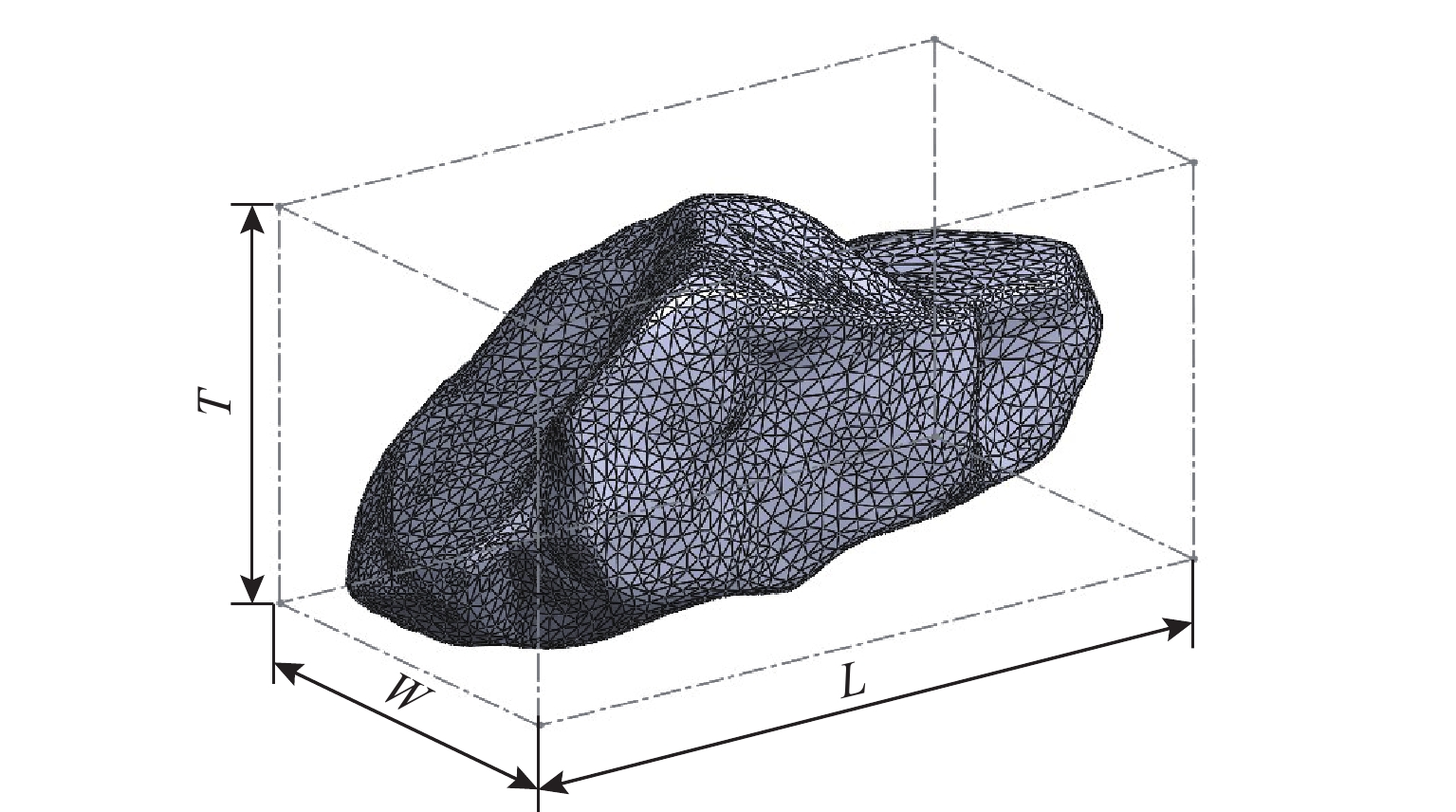
 下载:
下载:
